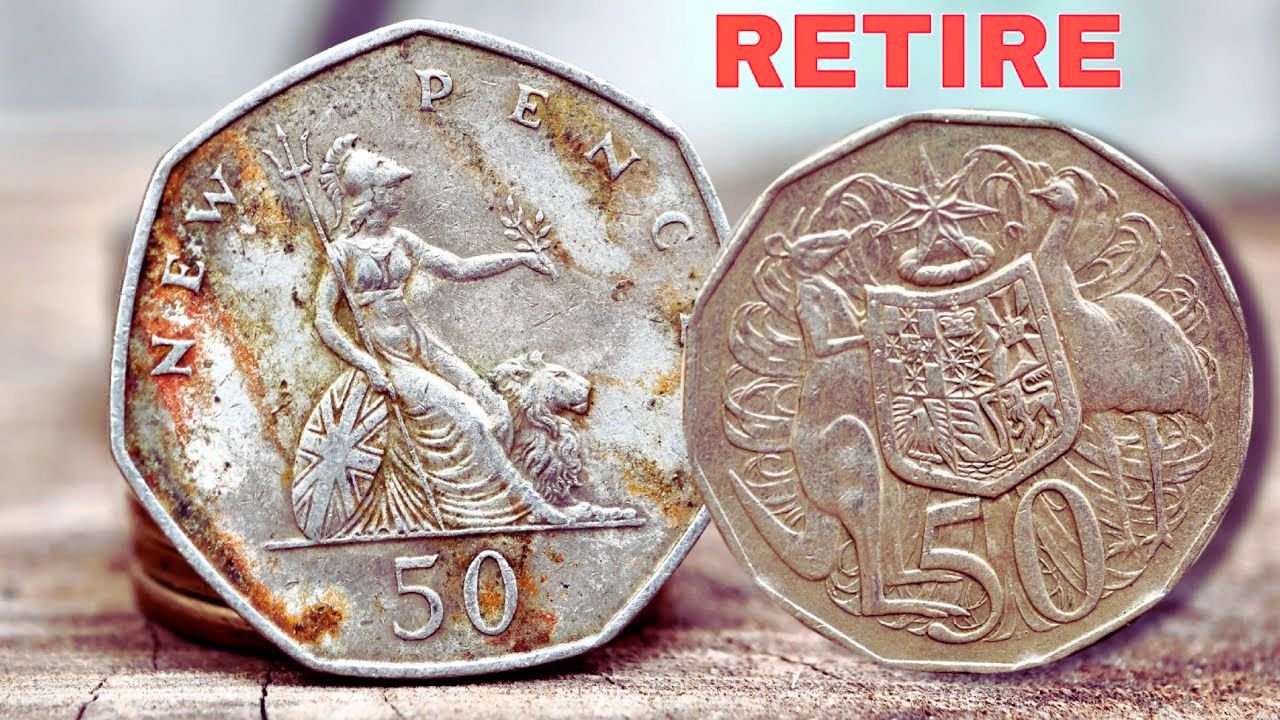You might have coins in your pocket that are worth more than their face value! Australian 50-cent and UK 50 new pence (now 50p) coins can sometimes be rare and valuable due to low mintages, errors, or unique designs. Below is a simple guide to the most valuable Australian 50-cent and UK 50p coins you could find in your change, written in easy English with details on what to look for and their potential worth.
Australian 50-Cent Coins to Look For
Australian 50-cent coins are large, 12-sided (dodecagonal), and often feature commemorative designs. The original 1966 round 50-cent coin was 80% silver, but most in circulation today are cupro-nickel. Here are the ones to check for:
1966 Round Silver 50-Cent Coin
Why Valuable?: Made of 80% silver, these coins were hoarded when silver prices rose, making them scarcer in circulation. Even worn ones are worth more due to their silver content.
What to Look For:
Round shape (not 12-sided).
Commonwealth Coat of Arms with a kangaroo and emu.
Queen Elizabeth II on the front (obverse).
Value:
Circulated: $8–$15 (based on silver price, ~$0.36/gram in 2025).
Uncirculated: $20–$50 or more if pristine.
Tip: Weigh it (13.28 grams); if it’s silver, it’s heavier than cupro-nickel coins.
2000 Millennium Incuse 50-Cent Coin
Why Valuable?: A rare version of the 2000 Millennium coin has an “incuse” (sunken) Union Jack flag instead of the usual raised design. Only about 200,000 were minted, likely from a test die for uncirculated sets.
What to Look For:
Stylized Australian flag with a sunken (recessed) Union Jack in the top left.
Run your finger over the flag; it feels indented, not raised.
Queen Elizabeth II on the front.
Value:
Circulated: $50–$200.
Uncirculated: $850–$3,000 on eBay (get it valued by a professional first).
Tip: Compare with a regular 2000 Millennium coin to spot the sunken flag.
Low Mintage Circulation Coins (1969, 1971–1974, 1985, 1993, 1997)
Why Valuable?: These standard Coat of Arms coins had lower mintages (under 3 million) and weren’t hoarded as much as commemoratives, so uncirculated ones are sought after.
What to Look For:
Dates: 1969, 1971, 1972, 1973, 1974, 1985, 1993, or 1997.
12-sided with kangaroo and emu Coat of Arms.
Queen Elizabeth II on the front.
Value (Uncirculated):
1969: ~$25.
1971: ~$25.
1972: ~$55.
1973: ~$60.
1974: ~$35.
1985: ~$13.
1993: ~$22.
Tip: Look for shiny, uncirculated coins with no wear; circulated ones are usually worth 50 cents.
Error Coins
Why Valuable?: Mistakes like off-center strikes, double dies (doubled design), or missing elements are rare and collectible.
What to Look For:
Off-center design (part of the coin blank).
Doubled letters or images (use a magnifying glass).
Unusual weight or color (e.g., missing cupro-nickel layer).
Value: $50–$1,000+ depending on the error and condition (consult a coin expert).
Tip: Errors are hard to spot; check coins carefully under light.
Notable Commemoratives (Low Mintage)
Examples:
1970 Captain Cook: Mintage 16.5 million, but uncirculated ones are collectible ($10–$20).
1991 Decimal Currency 25th Anniversary: Mintage 4.7 million ($5–$15 uncirculated).
1994 Year of the Family: Mintage 8.7 million ($5–$10 uncirculated).
What to Look For: Check the reverse for unique designs (e.g., Captain Cook’s ship, family silhouettes).
Tip: Most commemoratives (e.g., 1982 Commonwealth Games, 2001 Federation) have high mintages (10–20 million) and are worth 50 cents unless uncirculated or rare variants.
UK 50 New Pence (50p) Coins to Look For
The UK 50p coin, introduced in 1969 as “50 new pence” until 1981, is a seven-sided (equilateral curve heptagon) coin. It’s popular with collectors due to its many commemorative designs and rare variants. Here are the most valuable ones you might find in change:
2023 Atlantic Salmon 50p
Why Valuable?: With only 200,000 minted for circulation, it’s the rarest UK 50p in 2025, surpassing the Kew Gardens 50p. Released in November 2023 with King Charles III’s portrait, it’s highly sought after.
What to Look For:
Reverse: Atlantic salmon leaping from water.
Obverse: King Charles III with “2023” and no privy mark (a small crown on collector versions).
“FIFTY PENCE” below the salmon.
Value:
Circulated: £23–£150 on eBay (prices may rise).
Uncirculated: £200–£500+ as demand grows.
Tip: Check for the date on the obverse (King’s side); no privy mark means it’s a circulation coin.
2009 Kew Gardens 50p
Why Valuable?: Only 210,000 were minted, making it one of the rarest 50p coins until 2023. Its design celebrating the Kew Gardens pagoda is a collector favorite.
What to Look For:
Reverse: Chinese pagoda with climbing plant.
Obverse: Queen Elizabeth II (Ian Rank-Broadley portrait).
“FIFTY PENCE” and “2009” on the reverse.
Value:
Circulated: £150–$250.
Uncirculated: £300–$1,000 on eBay.
Tip: Many went to collections, so finding one in change is rare but possible.
1992–1993 Single Market 50p (Large Size)
Why Valuable?: With a mintage of 109,000, it’s the rarest large-size 50p (pre-1997, 30mm diameter). It commemorates the UK’s role in the European Single Market.
What to Look For:
Reverse: Table with 12 stars and “1992/3” (for EEC presidency).
Obverse: Queen Elizabeth II (Raphael Maklouf portrait).
Larger than modern 50p coins (27.3mm).
Value:
Circulated: £30–$100.
Tip: These old, large 50p coins are no longer legal tender but are collectible if found in old change or collections.
2011 Olympic Football 50p
Why Valuable?: Mintage of 1,125,500, one of the rarer Olympic 50p coins. Its design explaining the offside rule is unique and popular.
What to Look For:
Reverse: Football tactics board showing offside rule.
Obverse: Queen Elizabeth II (Ian Rank-Broadley portrait).
“FIFTY PENCE” and “2011” on the reverse.
Value:
Circulated: £5–$20.
Tip: Check Olympic 50p coins; others like Wrestling (1,129,500) or Judo (1,161,500) are also valuable.
Error Coins
1983 “New Pence” 50p:
Why Valuable?: In 1982, 50p coins changed from “NEW PENCE” to “FIFTY PENCE.” A few 1983 coins were mistakenly minted with “NEW PENCE,” making them rare.
What to Look For: “NEW PENCE” above Britannia on the reverse (not “FIFTY PENCE”).
Value: £100–$600 in perfect condition.
Undated 50p (Mule Error):
Why Valuable?: A 2008 minting error paired an old obverse with a new reverse, omitting the date. Estimated 50,000–200,000 exist, similar to the 20p mule.
What to Look For: No date on either side (check Britannia or Shield reverse).
Value: £50–$500, depending on condition.
Tip: Use a magnifying glass to spot subtle errors like “NEW PENCE” or missing dates.
Other Notable Commemoratives
2018 Flopsy Bunny 50p: Mintage 1,400,000, featuring Beatrix Potter’s character (~$5–$20 circulated).
1994 D-Day 50th Anniversary: Large-size coin, mintage 6.7 million ($5–$50 circulated).
Tip: Commemoratives like 2012 Olympics or Beatrix Potter series are common (5–10 million mintage) but worth $2–$10 if uncirculated.
Tips for Finding Valuable Coins
Check Your Change:
Australian 50-cent coins are still in circulation, especially commemoratives. Look for 1966 silver rounds or 2000 incuse variants.
UK 50p coins are common in change, but rare ones like the 2023 Salmon or 2009 Kew Gardens are harder to find. Check old coin jars or family collections for large-size 50p coins (pre-1997).
What to Inspect:
Date and Design: Look for specific years (e.g., 2000 incuse, 2023 Salmon) or low-mintage designs (e.g., Kew Gardens).
Condition: Uncirculated coins (shiny, no scratches) are worth more. Circulated coins lose value but are still collectible.
Errors: Check for off-center strikes, doubled letters, or wrong inscriptions (e.g., “NEW PENCE” on UK coins).
Weight and Size: Australian 1966 coins (13.28g, round); UK pre-1997 50p (13.5g, 30mm) vs. post-1997 (8g, 27.3mm).
Where to Look:
Coin rolls from banks, change from shops, or old piggy banks.
UK: Check change in England, Scotland, Wales, or Northern Ireland, as 50p coins circulate widely.
Australia: Look in change or at markets; silver 1966 coins may be in old collections.
How to Verify Value:
Use a magnifying glass to check details.
Compare with images on coin sites like coinscatalog.net (Australia) or coinchecker.co.uk (UK).
Get coins appraised by a dealer (e.g., The Purple Penny for Australia, Britannia Coin Company for UK) before selling on eBay to avoid scams.
Check eBay’s “sold” listings for real sale prices, not inflated asking prices.
Legal Tender:
Australian 50-cent coins are legal tender up to $5.
UK 50p coins are legal tender up to £10, but pre-1997 large coins are demonetized (still valuable to collectors).
The Bottom Line
Your pocket change could hide a treasure! For Australian 50-cent coins, the 1966 silver round and 2000 incuse Millennium are the top finds, potentially worth $15–$3,000. For UK 50p coins, the 2023 Atlantic Salmon and 2009 Kew Gardens are the rarest, fetching £23–$1,000. Error coins like the UK 1983 “New Pence” or undated mules are also valuable. Check dates, designs, and conditions carefully, and get rare finds appraised. Coin collecting is like a treasure hunt—have fun searching!
If you have a specific coin or want help identifying one, share details, and I’ll guide you further!



